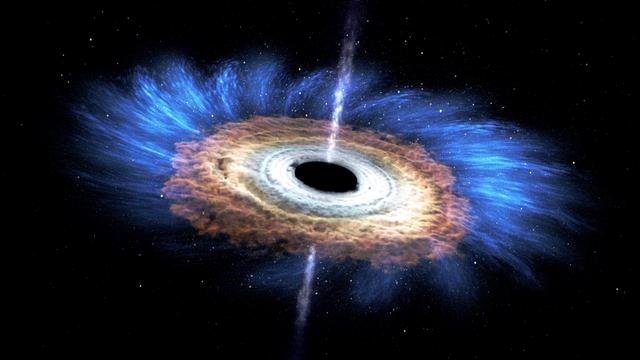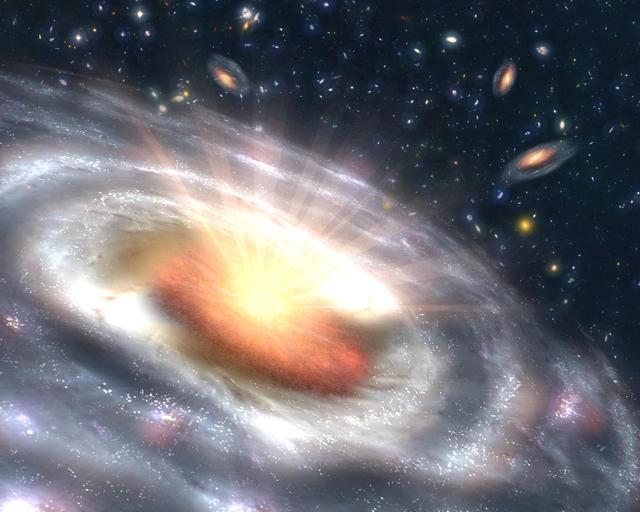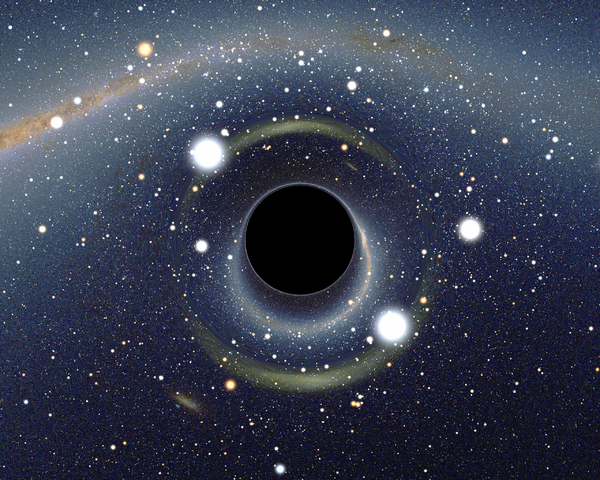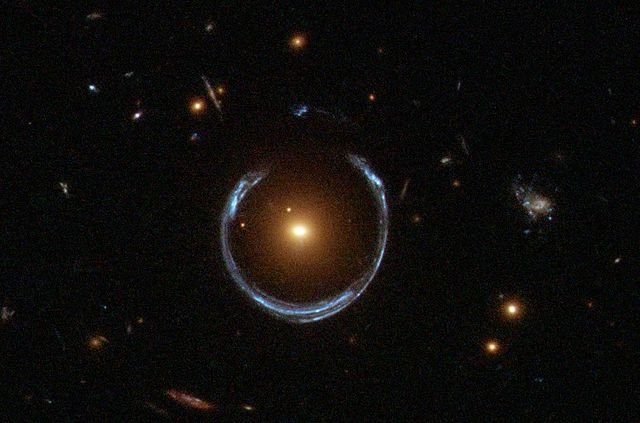Can dark matter be made of black holes (or machos)?
There are many theories in particle physics that predict a spectrum of elementary particles containing a dark matter candidate. In other words, these theories say that there exists one particle that plays the role of the dark matter that pervades our universe.
For these reasons, there are many experiments trying to get information on the nature of dark matter, each of them being dedicated to the search for one or the other of these dark matter candidates.

[image credits: NASA]
And up to now, most of them are still valid choices, although constraints exist.
I will today focus on one of these candidates: black holes.
There is a very fancy option that indeed postulates that dark matter could formed of black holes. In my previous post, I briefly introduced the concept of black holes and their connection with general relativity.
With this article, I will discuss how black hole could be connected, according to certain theories, to dark matter.
The motivation behind this post comes from two interesting articles which I have read earlier this month. The first one explained that black holes cannot entirely form dark mater, because data forbids it today.
And the second one said that the black hole option for dark matter was in contrast still allowed.
Kind of contradictory, isn’t it? Let us have a closer look! ;)
BLACK HOLES IN A NUTSHELL
In my previous post, I explained that spacetime was flat on large scales, and that masses produce deformations that bend it. The more compact is the mass, the more important will be the bending.

[image credits: Wikimedia]
This is depicted on the picture shown on the right.
A not too massive object like our sun induces a mild bending of spacetime. This can be checked by observing the grid representing spacetime (that flat surface) on the picture.
A much more compact neutron star generates a much more pronounced deformation, with a kind of deep well.
A [black hole]((https://en.wikipedia.org/wiki/Black_hole) finally leads to an infinite well. This is what is commonly referred to as the black hole singularity (even if there is no singularity on the picture as we can only draw finite stuff).
PRIMORDIAL BLACK HOLES
Generally, one says that black holes originate from the gravitational collapse of the core of a very massive star.

[image credits: NASA]
This collapse generates a massive explosion (a supernova) where the outer part of the star is sent far away into space, whilst the inner part gets denser and denser (see the illustration).
If the star is massive enough, the core of the star can become so dense that its gravitational collapse yields the formation of a black hole.
When we discuss about dark matter, we however need to introduce a special class of black holes, primordial black holes.
Those black holes are different from the above ones. They are hypothetical beasts that could have been created during the first moments of our universe.
Those black holes are lighter than those typically originating from the stars, and their masses vary from about a gram to several thousands of solar masses. Other mechanisms must thus be invoked to justify their presence. But this is not too complicated at the end of the day.
During its life, a black hole makes two things: first it grows by accreting matter, and next it evaporates, which is the phenomenon of Hawking radiation. According to the relative rates of these two phenomena, a black hole either grows, or shrinks.
Very light black holes have the tendency to evaporate kind of quickly (at least relatively to the age of the universe) so that all lighter primordial black holes should have disappeared today.
Primordial black holes of 1014 grams or more may thus still be there.
PRIMORDIAL BLACK HOLES AND MACHOS AS DARK MATTER
Such primordial black holes belong to the category of the so-called MACHOS, which is an acronym for massive compact halo objects. They consist of viable candidates for explaining the presence of dark matter in our universe.

[image credits: Wikipedia]
Those guys are indeed non-relativistic (and thus cold) and they leave no trace related to the current searches for dark matter (which is why we have not observed them yet).
They are additionally super-weakly interacting, which makes them stable (dark matter must be stable).
Those guys can however be constrained by a variety of measurements.
We can name, for instance, lensing contraints from supernovæ or the cosmic microwave background.
A funny coincidence is that the weakest constraints correspond to the mass values of the black holes observed by the LIGO and Virgo interferometers.
Oh-oh-oh, have we observed some primordial black holes that could be dark matter as well?
Whatever is the answer, the LIGO/Virgo observations has led to a revival of the interest in primordial black holes as a dark matter option.
ARE BLACK HOLES VIABLE OR NOT VIABLE DARK MATTER
As I said above, there is a variety of techniques allowing to test primordial black holes as dark matter. One of the best is to use the gravitational influence of black holes on light propagation.

[image credits: Wikipedia]
In short, one searches for microlensing observations, or for the magnification caused by compact objects moving near the light of sight.
In this article, the authors used supernovæ lensing, comparing the light originating from different supermovæ of the same type.
Such light should be highly magnified when passing close to a primordial black hole. And nothing was observed.
The authors then inferred some bounds on the primordial black hole abundance and they have been able to reject the hypothesis that dark matter could be entirely formed of primordial black holes.
However, in the second article, other physicists pointed out two caveats of the first analysis. First, the choice of priors on the cosmological parameters is questionable and it omits a few ingredients. Second, the typical size of the supernovæ was underestimated.
Putting all things together, the second analysis has actually shown that primordial black holes were still very good dark matter candidate, although the constraints are strong (but not strong enough to fully exclude the hypothesis).
TAKE-HOME MESSAGE
In this article, I detailed what were primordial black holes, and how different these guys were from more standard black holes. These primordial black holes have interesting properties that actually make them potential candidates for dark matter.
Two recent papers debated about this option being still viable in the light of current data and contradicted each other. And the answer is yes. One of the articles indeed made a mistake…
The future of the primordial black holes is thus not so dark (at least yet)!
For more discussion on this topic (or anything related to science), please join us on steemSTEM. SteemSTEM is a community driven project which seeks to promote well written/informative Science Technology Engineering and Mathematics postings on Steemit. More information can be found on the @steemstem blog.
We are currently consolidating the steemSTEM curation trail by different means. In the case where you would be interested, please contact us on the chat.
actually I do not know would like to comment what .. but, after reading this post many times, makes me want to discuss. but clarity is already available in this post. science is endless. we'll know when the time comes. and this is only for people who always think. this is amazing Prof ...
Thanks a lot for your nice comment. I really appreciate it! ^^
Yes, I like to call them "Dark Holes"
Naaah.... That sounds horrible :D
David Brin wrote a science fiction novel called Earth that goes into the making of these primordial black holes
I have checked and the book is about normal black holes, not primordial black holes. And it ignores black hole evaporation (I cannot prevent myself from acting as a physicist, even with science finction :p
Very informative post about black holes, I appreciate your effort, thanks for share
My pleasure! :)
Do black holes actually exist? From what I understand from the post, is that a black hole could be dark matter....I always thought black holes were voids of nothingness? I guess black holes are actually separate things that are made of of different forms of matter....interesting.... I wonder is they actually exist? And how would scientists prove what's in a black hole if everything is always "sucked-into" the black hole and cannot be returned....
Thanks for your questions. I will try to answer below. Do not hesitate to come back to me if necessary.
From the recent LIGO/Virgo observation, we have an indirect proof of their existence. The only explanation to the gravitational waves that have been generated by the merging of two black holes. No other object could explain this. This was the first evidence of a black hole.
Black holes are very compact and very dense objects, They have a mass, a spin, etc... and they interact.
Fascinating, thank you so much for the responses. Really appreciate it :)
My pleasure :)
Well there is another evidence for the existence of black holes (here, the super-massive one at the center of our galaxy): If you observe the motion of stars nearby, you observe that they are in orbit around a dark point, and that this point must have a huge mass.
That study took years, but the observation is pretty clear:
Yes, you are totally right. I forgot about those pieces of evidence (less exciting than the GW ones :) ).
oh wow @lemouth, cool coverage :) Thanks for the insights, and thanks for presenting it in a very understandable way :)
Iam quite interested in dark matter and black holes, sadly iam not able to understand half of the mathematics that is behind it :)
Anyways, thanks alot!
Kind regards
Jan
Thanks for your message! I have tried not to put any math here. I am convinced that 1/3 of the readers are lost at each equation :)
follow me and up-vote me
Please stop comment-spamming...
I think it's preposterous that the media keeps so much research and break through findings out the mainstream regarding outer space in general. The fact that we are able to create black holes here on earth by colliding particles is absolutely amazing. More information should be brought to the mainstream and people should learn that we need to evolve. Platforms like steemit make it possible for more people to come to the realization that we are a small spectacle of life and there is a whole universe beyond us and that even though it's not dramatized by media major break throughs are being made every day thanks to technology and people like you @lemouth .
Thanks for your nice comment. Reading it made me happy :)
Actually, in particle physics (and other domains as well), all research articles are available for free here. But I must admit that they are not very readable for the general audience. A platform like steemit in contrast allows some researchers (like me) to blog about their field and make them accessible to as many as possible :)
Just one point:
Actually, we are not. There are theories that predict that black holes could be created at the LHC (and will then evaporate super quickly), and there are searches for the associated phenomena. All the results are negative so far. But I will let you know if we find something :)
That's awesome, I didn't know that. Thank you for taking the time to respond to my comment.
My pleasure :)
"Dark Star Complex" is the tittle of this work of art that I created based on a theory of mine regarding Dark Star(Black Hole), Supernovae and Galaxies.
"Dark Star Cpmplex"
7.23.2014
Ink Pen On Wood Glossed
27.5in x 21.5in
This is beautiful :)
Why can't dark matter be black holes? Because even quiescent black holes tend to show up, through microlensing. Observational tests have put pretty rigorous constraints on a range of black holes masses in the Milky Way, although intergalactic black holes are not as well constrained.
The other problem is figuring out how you make lots of black holes, especially at smaller scales. That's not to say that scientists aren't still coming up with ideas, though. Warning: shameless plug. Further warning: We never found any empirical confirmation, so until that happens, it was just a promising idea that didn't pan out.
Well dark matter can be made of black holes. The idea is still valid. Constrained, but not excluded :)
follow me and up-vote me
Great Article @LeMouth.
A few questions/reflections:
Why limit ourselves to the observation of Supernovae to detect gravitational lensing caused by these primordial black-holes (BH)? Supernovae are great for their luminosity, but rare.
Shouldn’t we use other sources of light like large stars, cepheids in other galaxies, galaxies themselves or quasars? My favorite source would be the pulse of pulsars used as a probe for interstellar space. If such dark-matter-black-hole-sourced lensing is discovered and common, it would allow us to map these BH in 3D.
Also, if dark matter is made of undetected black holes, how to explain its distribution? Black holes emit energy (Hawkins radiation), and also interact gravitationally. Wouldn’t they end up forming a disk around the galaxy instead of a Halo? (In the WIMPS hypothesis, the fact that we have a Halo around galaxies is that WIMPS do not interact much with matter and themselves).
Actually my gut feeling tells me that there must be some undetected rogue black holes out there. I would tend to consider these as MACHOS (i.e. undetected normal matter). And these would account for a fraction of what is called dark matter, but this fraction would be in my humble opinion very small.
We don't. We use also constraints from gamma-rays derived from black holes evaporation, micro and femto-lensing, white-dwarf explosions, neutron-star capture the CMB, etc. All constraints put together allows to derive the current exclusion. What was interesting is that the less constrained region was the one potentially targetable by the supernovae.
Very succinctly, there are models with some PBH distributions that explain the observations. Those distributions involve halos. As this is not my field of expertise, I prefer to refer to this.
The first study proved that DM cannot be entirely made of PBH. In contrast, the second study exhibits errors made in the first and show that even if purely PBH-made dark matter was super-constrained, this was still allowed.